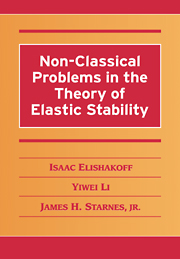Book contents
- Frontmatter
- Contents
- Preface: Why Still Another Book on Stability?
- 1 Mode Localization in Buckling of Structures
- 2 Deterministic Problems of Shells with Variable Thickness
- 3 Stochastic Buckling of Structures: Monte Carlo Method
- 4 Stochastic Buckling of Structures: Analytical and Numerical Non-Monte Carlo Techniques
- 5 Anti-Optimization in Buckling of Structures
- 6 Application of the Godunov-Conte Shooting Method to Buckling Analysis
- 7 Application of Computerized Symbolic Algebra in Buckling Analysis
- Bibliography
- Author Index
- Subject Index
1 - Mode Localization in Buckling of Structures
Published online by Cambridge University Press: 06 January 2010
- Frontmatter
- Contents
- Preface: Why Still Another Book on Stability?
- 1 Mode Localization in Buckling of Structures
- 2 Deterministic Problems of Shells with Variable Thickness
- 3 Stochastic Buckling of Structures: Monte Carlo Method
- 4 Stochastic Buckling of Structures: Analytical and Numerical Non-Monte Carlo Techniques
- 5 Anti-Optimization in Buckling of Structures
- 6 Application of the Godunov-Conte Shooting Method to Buckling Analysis
- 7 Application of Computerized Symbolic Algebra in Buckling Analysis
- Bibliography
- Author Index
- Subject Index
Summary
Think globally, act locally.
AnonymousThe genuine spirit of localism…
George BorrowThis chapter investigates the buckling mode localization in the periodic multi-span beams and plates. We start our discussion with disorder in two- and three-span elastic plates; then we focus our attention on the multi-span beams and plates with a disorder occurring in an arbitrary single span. The analytical finite difference calculus is employed to derive the transcendental equations from which buckling load is calculated. The underlying treatment is general, and the solution thus obtained is exact within the theory used. Numerical results show that the buckling mode is highly localized in the vicinity of the disordered span of the beam or the plate. In the multi-span, elastic plates are considered with transverse stiffeners, and the discreteness of the stiffeners is accounted for. The torsional rigidity of the stiffener is found to play an important role in the buckling mode pattern. When the torsional rigidity is properly adjusted, the stiffener can be used in passive control; that is, it can serve as an isolator of deformation for the structure at buckling so that the deflection is limited to only a small area.
Localization in Elastic Plates Due to Misplacement in the Stiffener Location
Traditionally, the stability of the stiffened plate has been studied following three different settings.
- Type
- Chapter
- Information
- Publisher: Cambridge University PressPrint publication year: 2001



